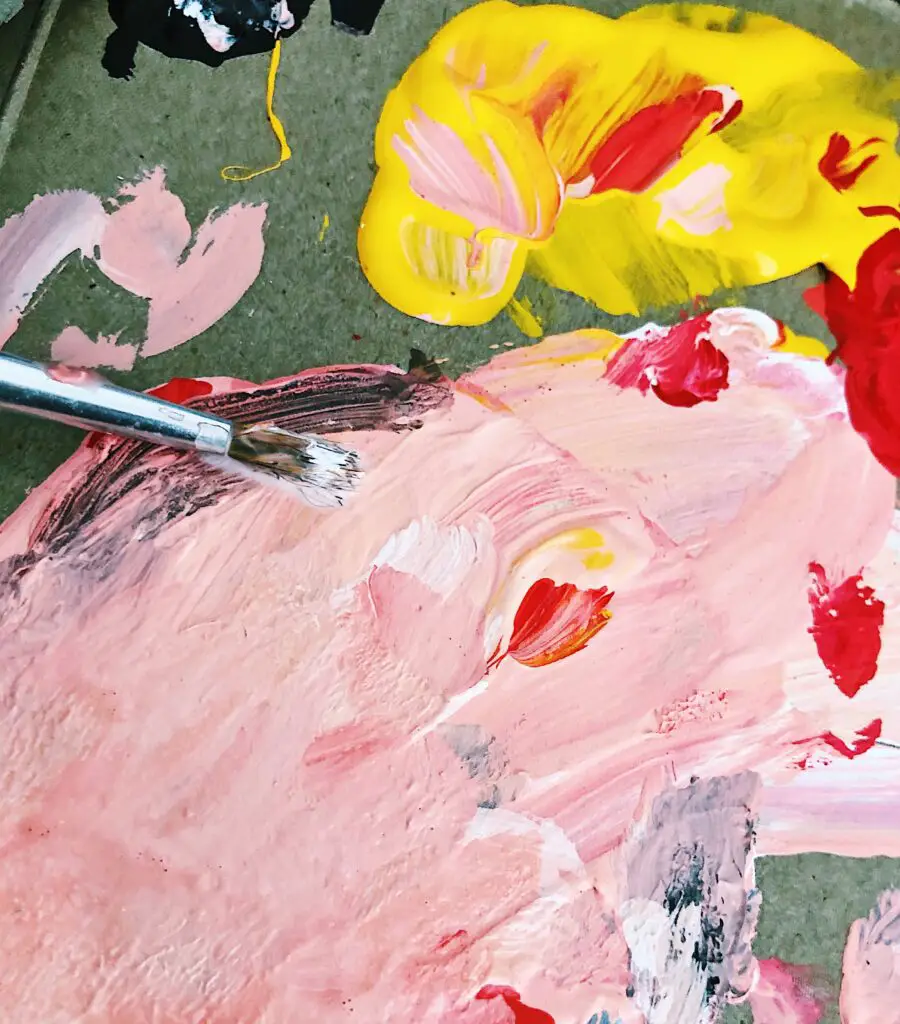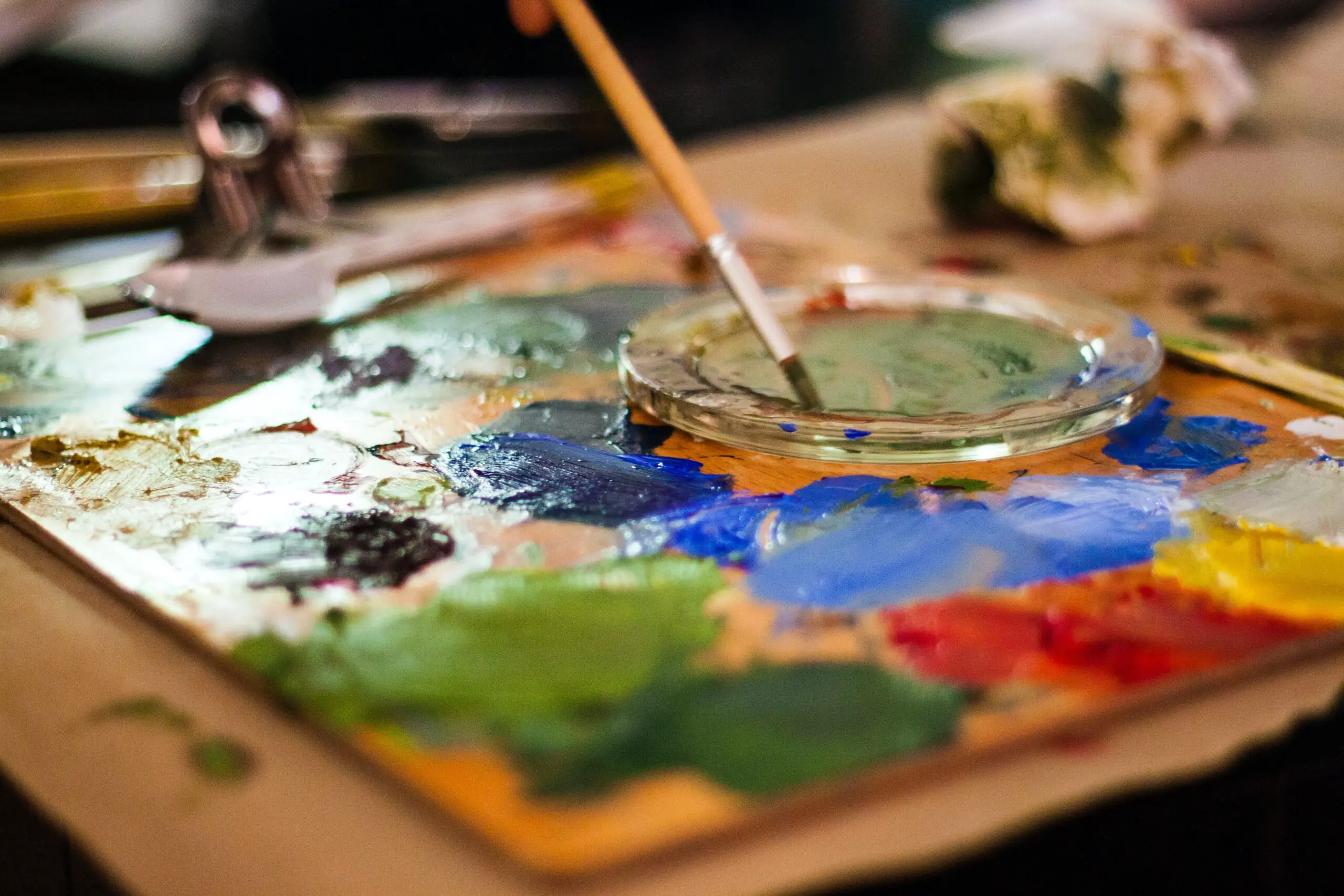You might already be an acrylic artist like me. But as you know acrylic paint is essentially plastics. That is why it can offer us all the good stuff that oil paints cannot offer. So, is there a better alternative for acrylic paint?
The best eco-friendly alternative to acrylic paint, concerning the plastics it contains, are egg tempera, watercolors, regular tempera, and poster colors. Use sustainable and eco-friendly surfaces for these paints. Overall all paints are not eco-friendly or sustainable in one way or another.
You will understand more about being eco-friendly and sustainable when you understand these terms and paint themselves. I will be explaining these terms and their relation to acrylic paint in simple terms below.
Is acrylic paint plastic?
Acrylic paint is an emulsion of plastic and pigment particles in water. In other words, acrylic polymer or plastic particles and pigment particles are suspended in water in acrylic paint. Water keeps the paint fluid.
Once the water evaporated from the paint, plastic or acrylic polymer particles come together and tighten in a honeycomb structure while trapping pigment particles. This is called the acrylic paint film on a surface. It is essentially a thin plastic layer.
The reason acrylic paint is very durable, water-resistant, and permanent is that it is made from acrylic polymer binder, which is plastic. That is how you can produce archival-quality paintings that last for many decades.
Although plastic in acrylic paint provides us with all those benefits, there is an environmental concern. Let’s discuss what is eco-friendly in the next section.
Is acrylic paint microplastic?
Microplastic is tiny plastic particles of five millimeters (0.2 inches) in diameter (source). Acrylic paint when dry can produce these small plastic particles. You can also find small plastic particles as it is in cosmetic products, microfibers shredded from textile, and fish nets. Microplastics are also produced by breaking the larger plastics like plastic water bottles(source).
Microplastics have the same harmfulness to the environment as larger plastic as they are not breaking down into less harmful versions. Most of these microplastics can be carried out into the waterways and travel up in the food pyramid. Eventually, they can end up in the food we consume.
What is being eco-friendly?
Eco-friendly is often a marketing term and it is ambiguous. It explains a product, service, law, policy, or guideline that helps to reduce or stop the harm to the environment or ecosystem at large. All eco-friendly practices are a part of sustainable development.
Is acrylic paint eco-friendly?
Now you can apply the term eco-friendliness to the art you are doing. Ask yourself the questions if painting with acrylics harms the ecosystem and is it a sustainable practice.
The immediate answer is no to the first part of the question and yes to the second part of the question. Acrylic paint may harm the ecosystem if not used properly, but it is a very sustainable art medium as most other art mediums. More will be discussed further in this article.

Like all plastic materials, acrylic paint is made up of a polymer which is a long chain of carbon and hydrogen atoms. We call this acrylic polymer binder. It is the binder that holds pigments together in place and provides all the unique properties of acrylic paint.
Sustainability has three pillars. When you are checking if anything is sustainable, see if that is environmentally, economically, and socially sustainable.
So at first, you might think plastic or acrylic paint is not sustainable because it comes from a non-renewable source which is petroleum or natural gases.
Although plastic originated from petroleum oil, plastic only uses 4% of oil sources in the world (source). Therefore plastic is said to be comparatively environmentally sustainable. Also, it is economically sustainable as it is a massive industry like acrylic paints.
Plastic or acrylic paints are highly socially sustainable as most artists love these materials, also they are very beginner-friendly. So many carriers are built around the acrylic paint industry as well as people love to use this art medium. Thus acrylic paint is socially sustainable.
The problem is with how we dispose of our acrylic paints. If we learn how to dispose of acrylic paint properly then we can make acrylic painting a sustainable and less invasive practice. More on this will be discussed in the below sections.
The best eco-friendly alternative for acrylic paint
There is no true eco-friendly alternative for acrylic paint. Art generally is not eco-friendly. The most eco-friendly solutions are not sustainable.
The best eco-friendly solution for acrylic paint that I see is watercolors. Watercolors have no plastic, it is completely water-soluble and has almost zero waste. Even if there are any toxic pigments in watercolors it is so much diluted and almost no amount of harmful pigments runs down the drain.
But watercolors require watercolor paper. Paper is not good for the environment as they come from trees. There are no options for watercolors other than using good-quality watercolor paper.
You might have heard about a medium called egg tempera. It is one of the earliest paints used in history between 1400-1450. It is made from all-natural ingredients like egg yolk, water, and natural pigments. It can be painted on wood panels and paper.
You will need to use multiple eggs in one painting session with egg tempera. The powdered paint pigments are mixed with egg yolk and water to make egg tempera paint. Most of these all-natural paints make flat-looking paintings. Some common examples are egg tempera and gouache.
However, you need to consider the sustainability of these paint where natural pigment powders are used. You need to take precautions to avoid inhalation of the pigment particles which I am not sure how many artists would follow. Otherwise, the powdered pigments can go through your lungs and cause serious health issues.
Also if you use cadmium or lead pigments, they will be drained down the sink to flow freely into the waterways, which is more dangerous when you think about the environment.
Biodegradable acrylic paint
There are some biodegradable acrylic paint brands on the market. They claim to use a natural acrylic binder. Again these brands require you to work with powdered natural pigments. Although these pigments are fully natural, they should be handled with care like with egg tempera.
You will need to use a mask or a respirator when using these powdery paint pigments. Therefore I do not see them as a good alternative to acrylic paints. Because acrylic paint when dry dries along with its pigments. Pigments are tightly bound with the binder so they do not go to the waterways.

If you can minimize the waste with acrylic paint, and that is your preferred art medium it is the best way to go for it. Because in the end art is not so much of an eco-friendly process. Even when it is eco-friendly I am more concerned about sustainability.
If you think acrylic paint is not eco-friendly even when the waste is managed then you can go for a fully natural option like watercolor, egg tempera, regular tempera, gouache, or poster color.
The only permanent paint from these is egg tempera. Others are not permanent and can be reactivated with water. Regular gouache and poster colors are generally used for temporary artwork rather than for archival quality artwork.
Eco-friendly acrylic house paints…
Many paints contain VOC (Volatile Organic Compounds) when it comes to house paints including acrylic paint. You can generally smell these off-gases that contain VOC. Look for paints that indicate zero or low VOC in the label for the betterment of you as well as the environment.
You can also use all-natural house paints like ‘milk paint’. It is made from ingredients such as clay, pigment, milk protein, and lime. It is a nontoxic and biodegradable paint that provides more of a vintage look. However, these paints are not flexible and water-resistant like acrylic paint because they do not have a plastic nature.
How to dispose of acrylic paint properly?
As I have described above acrylic paint or plastic is a sustainable solution for us. We absolutely will not be able to live without a material like plastic. The most important thing you need to consider is how you dispose of acrylic paint or plastic.
The best way to dispose of plastic is to recycle them. You can recycle acrylic paint the same as plastic when they are dry. Usually the layers of paint you peel off the palette can be recycled.
Disposing of any paints when they are wet is more harmful than disposing of them when they are dry. Because when the paint is wet particles can move freely in the environment including the pigments. Especially there can be cadmium and lead pigments in acrylic paint which can move freely in waterways if you dispose of them wet, usually if you dispose of dirty paint water down the drain.
When the paint is dry acrylic polymer trap pigments inside the honeycomb polymer structure and keeps pigments in place. Therefore the chance is less for harmful pigments to release unsafely into the environment.
If you are thinking about burning acrylic paint or acrylic painting, you will need to know about the flammability and the harmful effects of burning acrylic paint. You can find that information in the following article: Is acrylic paint flammable? (According to industry standards)
When painting with acrylic water is our good friend as acrylic paint is waterbased. So when you want to wash your brush, palette, or pallet knife first wipe it off with a rag or a paper towel (a rag is the best choice as paper towels may not be sustainable).
Then you can let those accessories dry and dispose of the paint by removing the dry paint in layers. Then you can wash these accessories in the sink and down the drain as there is only a little paint left. It is perfectly fine to wash the brush, palette knife, palette, etc. with water after removing the excess paint with a rag.
I have written a whole article about, ‘Is acrylic paint harmful? (In different routes of exposure)‘ There you will find the extent of harmfulness in different routes of exposure to acrylic paint. You can become a successful, informed artist with no adverse effects from using a chemical to create beautiful art.
More ways to make acrylic paint eco friendly
Another way to make acrylic paint eco-friendly is by reducing paint waste. only take the amount of paint you need onto the palette. Do not use more paint than you need. Use a stay-wet palette so that you can keep acrylic paint wet for a long time and avoid waste.
You can also mist acrylic paint on the palette to keep the paint wet for a long time. Also, keep acrylic paints in optimal condition most of the time. Avoid very high or low temperatures, and clean and close the acrylic paint lids properly.
You can read more about the proper usage of acrylic paint and keeping them for a long time by reading the following article: How long does acrylic paint last? All you need to know.
If you have any paints that you no longer use you can donate them to the needy. Many charities may accept these paints. You can also give them to your artsy friend.

Conclusion
There is no true eco-friendly alternative for acrylic paint. If you are more concerned about the plastics in acrylic paint then you can use paint made with a natural binder like watercolor, regular tempera, egg tempera, gouache, or poster colors depending on the purpose. Take necessary precautions when using powdered pigments. Also choose an eco-friendly painting surface, something more sustainable than paper.
FAQ
Can you use oil paint instead of acrylic?
You can use oil paint instead of acrylic paint. Oil paint can be painted on top of acrylic paint but not vice versa. Always follow the fat over lean rule where oil paint is fat and acrylic paint is lean. However, oil paint itself can be natural but the mediums used with it like mineral spirits emit toxic fumes.
Can I use wall paint instead of acrylic?
In general, wall paints or emulsion paints cannot be used instead of acrylic paint as the paint film is not flexible and can be reactivated with water. They are prone to cracking when thickly applied. However, some artists have had success using house paints with a pouring medium like Floetrol in acrylic pour art.
Resources:


